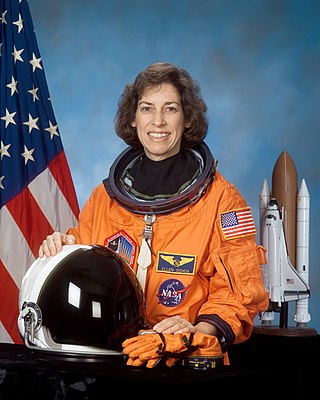Related Research Articles

The Ames Research Center (ARC), also known as NASA Ames, is a major NASA research center at Moffett Federal Airfield in California's Silicon Valley. It was founded in 1939 as the second National Advisory Committee for Aeronautics (NACA) laboratory. That agency was dissolved and its assets and personnel transferred to the newly created National Aeronautics and Space Administration (NASA) on October 1, 1958. NASA Ames is named in honor of Joseph Sweetman Ames, a physicist and one of the founding members of NACA. At last estimate NASA Ames had over US$3 billion in capital equipment, 2,300 research personnel and a US$860 million annual budget.

Mountain View is a city in Santa Clara County, California, United States. Named for its views of the Santa Cruz Mountains, it has a population of 82,376 as of the 2020 census.

Lynbrook High School is a co-educational, public, four-year high school located in the West San Jose neighborhood of San Jose, California. It was founded in 1965 and graduated its first class in 1968.

San José State University is a public university in San Jose, California. Established in 1857, SJSU is the oldest public university on the West Coast and the founding campus of the California State University (CSU) system.

Ellen Ochoa is an American engineer, former astronaut and former director of the Johnson Space Center. In 1993, Ochoa became the first Hispanic woman to go to space when she served on a nine-day mission aboard the Space Shuttle Discovery. Ochoa became director of the center upon the retirement of the previous director, Michael Coats, on December 31, 2012. She was the first Hispanic director and the second female director of Johnson Space Center.

Maze, also known as Maze War, is a 3D multiplayer first-person shooter maze game originally developed in 1973 and expanded in 1974. The first version was developed by high school students Steve Colley, Greg Thompson, and Howard Palmer for the Imlac PDS-1 minicomputer during a school work/study program at the NASA Ames Research Center. By the end of 1973 the game featured shooting elements and could be played on two computers connected together. After Thompson began school at the Massachusetts Institute of Technology (MIT), he brought the game to the school's computer science laboratory in February 1974, where he and Dave Lebling expanded it into an eight-player game using the school's Digital Equipment Corporation PDP-10 minicomputer and PDS-1 terminals along with adding scoring, top-down map views, and a level editor. Other programmers at MIT improved this version of the game, which was also playable between people at different universities over the nascent ARPANET. Due to the popularity of the game, laboratory managers at MIT both played it while also trying to restrict its use due to the large amount of time students were spending on it. There are reports that the Defense Advanced Research Projects Agency (DARPA) at one point banned the game from the ARPANET due to its popularity.

James Lick High School is a public high school in San Jose, California, US, located in the Alum Rock district of East San Jose. The school is part of the East Side Union High School District.

Leland High School is a public high school located in the Almaden Valley in San Jose, California. Leland is one of the nine high schools in the San Jose Unified School District and is a STEM school.

Joseph Sweetman Ames was a physicist, professor at Johns Hopkins University, provost of the university from 1926 to 1929, and university president from 1929 to 1935. He is best remembered as one of the founding members of the National Advisory Committee for Aeronautics and its longtime chairman (1919–1939). NASA Ames Research Center is named after him. He was elected a Fellow of the American Academy of Arts and Sciences in 1911. He was the 1935 recipient of the Langley Gold Medal from the Smithsonian Institution.

FIRST Robotics Competition (FRC) is an international high school robotics competition. Each year, teams of high school students, coaches, and mentors work during a six-week period to build robots capable of competing in that year's game that weigh up to 125 pounds (57 kg). Robots complete tasks such as scoring balls into goals, placing inner tubes onto racks, hanging on bars, and balancing robots on balance beams. The game, along with the required set of tasks, changes annually. While teams are given a kit of a standard set of parts during the annual Kickoff, they are also allowed and encouraged to buy or fabricate specialized parts. FIRST Robotics Competition is one of five robotics competition programs organized by FIRST, the other four being FIRST LEGO League Discover, FIRST LEGO League Explore, FIRST LEGO League Challenge, and FIRST Tech Challenge.

Dave Lavery is an American scientist and roboticist who is the Program Executive for Solar System Exploration at NASA Headquarters. He also is a member of the FIRST Executive Advisory Board, and is well-known among participants of the FIRST Robotics Competition as a mentor of Team 116.

Gregory Errol Chamitoff is a Canadian-born American engineer and former NASA astronaut. He has been to space twice, spending 6 months aboard the ISS across Expedition 17 and 18 in 2008, and another 15 days as part of STS-134 in 2011. STS-134 was the last of Space Shuttle Endeavour which delivered the Alpha Magnetic Spectrometer and completed the US Orbital Segment.

Clarence A. "Sy" Syvertson (1926-2010) was the Center Director of the Ames Research Center of the National Aeronautics and Space Administration, located at Moffett Field, California.

NASA Research Park is a research park operated by NASA near San Jose, California, which is developing a shared-use research and development campus in association with government entities, academia, industry and nonprofit organizations. NASA Research Park was approved by NASA in the fall of 2002 and had been active since then.

The history of science and technology in Mexico spans many years.

For Inspiration and Recognition of Science and Technology (FIRST) is an international youth organization that operates the FIRST Robotics Competition, FIRST LEGO League Challenge, FIRST LEGO League Explore, FIRST LEGO League Discover, and FIRST Tech Challenge competitions. Founded by Dean Kamen and Woodie Flowers in 1989, its expressed goal is to develop ways to inspire students in engineering and technology fields. Its philosophy is expressed by the organization as Coopertition and Gracious Professionalism. FIRST also operates FIRST Place, a research facility at FIRST Headquarters in Manchester, New Hampshire, where it holds educational programs and day camps for students and teachers.

David Morrison is an American astronomer, a senior scientist at the Solar System Exploration Research Virtual Institute, at NASA Ames Research Center in Mountain View, California. Morrison is the former director of the Carl Sagan Center for Study of Life in the Universe at the SETI Institute and of the NASA Lunar Science Institute. He is the past Director of Space at NASA Ames. Morrison is credited as a founder of the multi-disciplinary field of astrobiology. Morrison is best known for his work in risk assessment of near Earth objects such as asteroids and comets. Asteroid 2410 Morrison was named in his honor. Morrison is also known for his "Ask an Astrobiologist" series on NASA's website where he provides answers to questions submitted by the public. He has published 12 books and over 150 papers primarily on planetary science, astrobiology and near Earth objects.
Team 1717, D’Penguineers, were a FIRST Robotics team associated with the Dos Pueblos High School Engineering Academy (DPEA) in Goleta, California. D’Penguineers have won multiple awards at the regional and international levels of the FIRST Robotics Competition, and participate regularly in outreach programs for junior high and elementary schools. The team was highlighted in the book The New Cool.

Plano ISD Academy High School, commonly referred to as Academy High School, is a STEAM, interdisciplinary and project-based learning high school. The school serves students from grades 9-12. This school is not a regular secondary school because this school uses a selection process to draw eighth graders from various middle schools in Plano ISD. The school is an alternative to the regular high school experience by offering collaborative team projects, more STEAM classes and the ability to attend classes without structured class periods. This school is one of the three Academy Programs in Plano ISD. The others are the Plano ISD Health Sciences Academy and The IB World School at Plano East.
Yvonne Jean Pendleton is an American astrophysicist and is currently the Chief Scientist of NASA’s Solar System Exploration Research Virtual Institute (SSERVI) at Ames Research Center in Mountain View, California. Pendleton earned degrees from the Georgia Institute of Technology, Stanford University, and the University of California at Santa Cruz and was hired by NASA as a civil servant in 1979. She served as a research scientist in the Space Science and Astrobiology Division at NASA Ames Research Center (ARC) until 2007, including as Division Chief from 2006-7. In 2007 she was promoted to the Senior Executive Service, the highest level of civil service within the Federal government, and throughout her career has served in high-level leadership positions at both NASA's ARC and Headquarters. Her scientific research has investigated the origin and evolution of organic material in our galaxy and is currently focused on the composition of the solar nebula from which our Solar System formed. She is an elected fellow of the California Academy of Sciences and Asteroid 7165. Pendleton was named by the International Astronomical Union in honor of her research contributions.
References
- 1 2 3 4 "Mark Leon, Helping Kids Build a Better Robot". Archived from the original on 2009-09-30.
- ↑ Mark León - NASA Learning Technologies
- 1 2 "Spaceward Bound, Mark Leon". Archived from the original on 2016-05-20.
- ↑ Mark Leon
- ↑ "Mark Leon has left the planet". Chief Delphi. 31 December 2018. Retrieved 18 May 2020.
- ↑ NASA Ames Robotics Academy